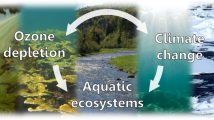Summary
Stratospheric ozone depletion has the potential to exert very substantial effects on the environment. However, our ability to predict with confidence and precision the likelihood of occurrence of particular effects, and to quantify their anticipated ultimate scope, varies greatly due to differences in the current level of our state of knowledge about particular types of effects. A major dilemma is the fact that our state of knowledge, even now, is low with regard to certain effects that have the greatest potential for widespread global impacts. For example, the current state of knowledge concerning potential effects of increased UV-B radiation on aquatic systems is relatively low, but the resultant global impact on human health and the environment could be quite high (Table 1).
For aquatic systems, studies are needed to elucidate how UV-B effects are modified by additional biotic and abiotic factors, such as carbon dioxide, temperature, nutrient stress, heavy metals, diseases, and predators. The manner and magnitude of adaptation to increased UV-B radiation, such as by increased screening pigments or enhanced DNA-damage repair capacity, need to be investigated both as adaptation capacity of individual organisms and as genetically based changes in populations. In addition, there is a need for sufficient information on productivity and other responses using realistic UV-B enhancements under field conditions.
Research priorities continue to relate to UV-B penetration into the water column and throught ice. This basic physical information should then be used both in laboratory and field research to determine effects on phytoplankton and zooplankton. In addition, adaptive strategies of organisms in freshwater and marine communities need to be studied over extended periods of time, as well as the effects of interactive stresses (temperature, salinity, ect.) and cumulative doses received over the lifetime of organisms. And finally, plankton effects should be modeled into broader ecosystem dynamic patterns, which will feed into models of global carbon and nitrogen cycling.
Access this chapter
Tax calculation will be finalised at checkout
Purchases are for personal use only
Similar content being viewed by others
Author information
Authors and Affiliations
Editor information
Editors and Affiliations
Rights and permissions
Copyright information
© 1994 Springer-Verlag Berlin Heidelberg
About this paper
Cite this paper
Worrest, R.C. (1994). Aquatic Systems (Freshwater and Marine). In: Biggs, R.H., Joyner, M.E.B. (eds) Stratospheric Ozone Depletion/UV-B Radiation in the Biosphere. NATO ASI Series, vol 18. Springer, Berlin, Heidelberg. https://doi.org/10.1007/978-3-642-78884-0_17
Download citation
DOI: https://doi.org/10.1007/978-3-642-78884-0_17
Publisher Name: Springer, Berlin, Heidelberg
Print ISBN: 978-3-642-78886-4
Online ISBN: 978-3-642-78884-0
eBook Packages: Springer Book Archive




